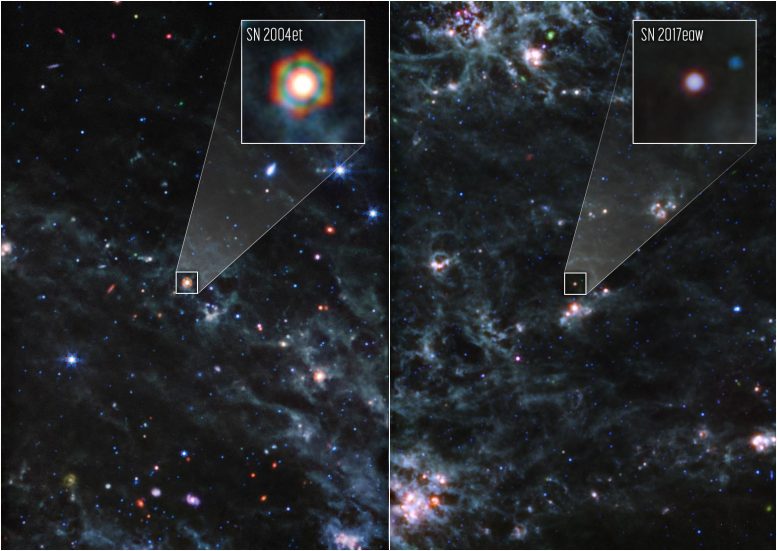
Images from NASA’s James Webb Space Telescope’s MIRI (Mid-Infrared Instrument) reveal large amounts of dust within two Type II supernovae, Supernova 2004et (SN2004 et) and Supernova 2017eaw (SN 2017eaw), located 22 million light-years away from Earth in spiral galaxy NGC 6946. The large amounts of dust found around these supernovae support the theory that supernovae played a key role in supplying dust to the early universe.
SN 2004et is highlighted in the left panel of this image, and SN 2017eaw in the right panel. Webb’s exquisite sensitivity and capability to observe in the mid-infrared allow it to detect the cooler dust that survived the internal shocks reverberating in the aftermath of the dying stars’ explosions. In these images, the bluer colors indicate hotter dust, while red is cooler dust.
Credit: NASA, ESA, CSA, Ori Fox (STScI), Melissa Shahbandeh (STScI), Alyssa Pagan (STScI)
New finding suggests supernovae are likely suppliers of dust to early, young galaxies.
Supernovae, the explosive deaths of stars, are some of the universe’s biggest bursts of energy and light. In fact, when they erupt, one supernova can shine even brighter than an entire galaxy.
It’s a fitting reason for NGC 6946, located 22 million light-years away from Earth, to be nicknamed the Fireworks Galaxy. In the past century, nearly a dozen supernovae have been observed flashing in the arms of this galaxy.
This includes Supernova 2004et and Supernova 2017eaw, which researchers are now studying with the James Webb Space Telescope’s MIRI (Mid-Infrared Instrument). Their findings have been surprising—MIRI detected large amounts of dust within the ejecta of each of these objects. The mass found by researchers supports the theory that supernovae played a key role in supplying dust to the early universe.
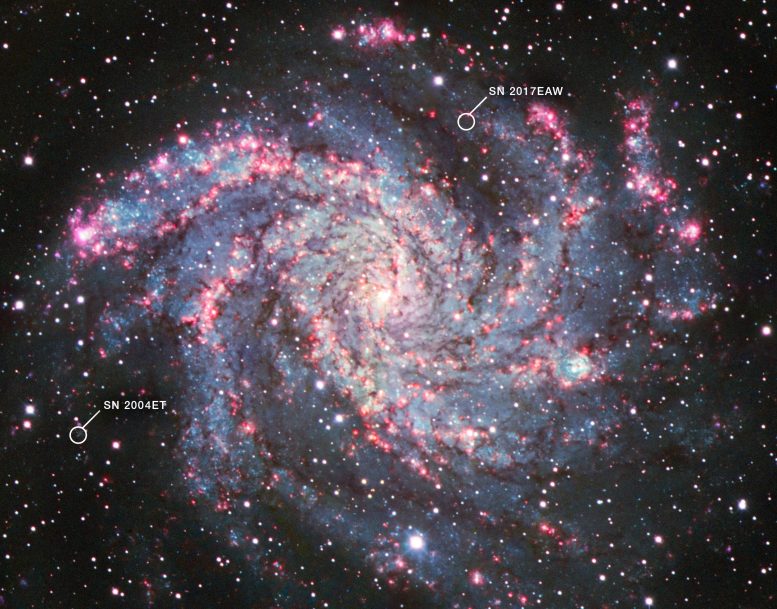
This image from the Kitt Peak National Observatory of NGC 6946 contextualizes the locations of Supernova 2004et and Supernova 2017eaw within the galaxy. Scientists using NASA’s James Webb Space Telescope’s MIRI (Mid-Infrared Instrument) found large amounts of dust within two Type II supernovae, Supernova 2004et (SN 2004et) and Supernova 2017eaw (SN 2017eaw), located 22 million light-years away from Earth in the spiral galaxy NGC 6946. The large amounts of dust found in these supernovae using MIRI support that supernovae played a key role in supplying dust to the early universe.
Credit: KPNO, NSF’s NOIRLab, AURA, Alyssa Pagan (STScI)
Webb Space Telescope Locates Dust Reservoirs in Two Supernovae
Researchers using NASA’s James Webb Space Telescope have made major strides in confirming the source of dust in early galaxies. Observations of two Type II supernovae, Supernova 2004et (SN 2004et) and Supernova 2017eaw (SN 2017eaw), have revealed large amounts of dust within the ejecta of each of these objects. The mass found by researchers supports the theory that supernovae played a key role in supplying dust to the early universe.
Dust: The Galactic Building Block
Dust is a building block for many things in our universe – planets in particular. As dust from dying stars spreads through space, it carries essential elements to help give birth to the next generation of stars and their planets. Where that dust comes from has puzzled astronomers for decades. One significant source of cosmic dust could be supernovae – after the dying star explodes, its leftover gas expands and cools to create dust.
“Direct evidence of this phenomenon has been slim up to this point, with our capabilities only allowing us to study the dust population in one relatively nearby supernova to date – Supernova 1987A, 170,000 light-years away from Earth,” said lead author Melissa Shahbandeh of Johns Hopkins University and the Space Telescope Science Institute in Baltimore, Maryland. “When the gas cools enough to form dust, that dust is only detectable at mid-infrared wavelengths provided you have enough sensitivity.”
For supernovae more distant than SN 1987A like SN 2004et and SN 2017eaw, both in NGC 6946 (see image above) about 22 million light-years away, that combination of wavelength coverage and exquisite sensitivity can only be obtained with Webb’s MIRI (Mid-Infrared Instrument).
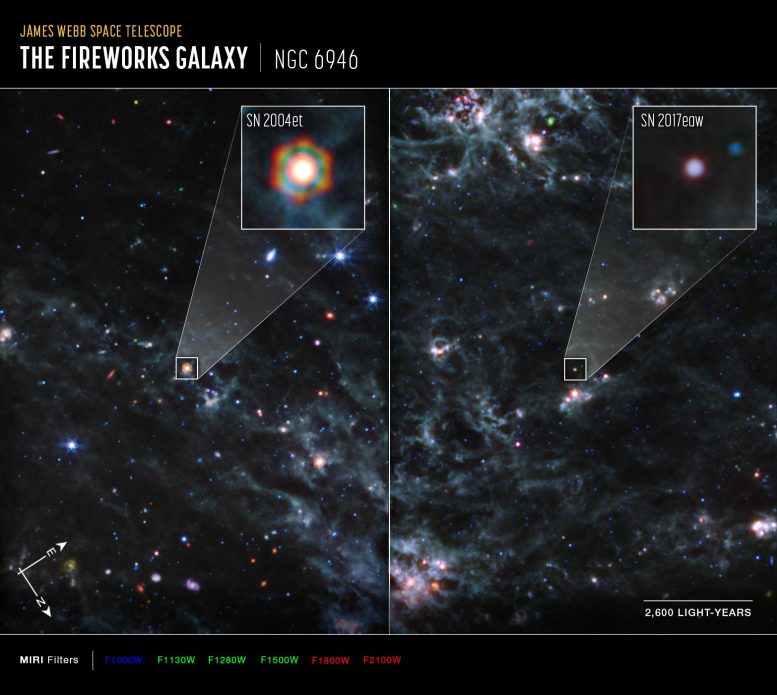
This image of NGC 6946 highlighting two supernovae, SN 2004et and SN 2017eaw, by Webb’s MIRI (Mid-Infrared Camera), shows compass arrows, scale bar, and color key for reference.
The north and east compass arrows show the orientation of the image on the sky. The scale bar is labeled 2,600 light-years.
This image shows invisible mid-infrared wavelengths of light that have been translated into visible-light colors. The color key shows which MIRI filters were used when collecting the light. The color of each filter name is the visible light color used to represent the infrared light that passes through that filter. In these images, blue, green, and red were assigned to Webb’s MIRI data at 10; 11.3, 12.8, and 15.0; and 18 and 21 microns (F1000W; F1130W, F1280W, and F1500W; and F1800W and F2100W, respectively).
Credit: NASA, ESA, CSA, Ori Fox (STScI), Melissa Shahbandeh (STScI), Alyssa Pagan (STScI)
Significant Discoveries and Implications
The Webb observations are the first breakthrough in the study of dust production from supernovae since the detection of newly formed dust in SN 1987A with the Atacama Large Millimeter/submillimeter Array (ALMA) telescope nearly a decade ago.
Another particularly intriguing result of their study isn’t just the detection of dust, but the amount of dust detected at this early stage in the supernova’s life. In SN 2004et, the scientists discovered more than 5,000 Earth masses of dust.
“When you look at the calculation of how much dust we’re seeing in SN 2004et especially, it rivals the measurements in SN 1987A, and it’s only a fraction of the age,” added program lead Ori Fox of the Space Telescope Science Institute. “It’s the highest dust mass detected in supernovae since SN 1987A.”
Observations have shown astronomers that young, distant galaxies are brimming with dust, but these galaxies are not old enough for intermediate-mass stars, like the Sun, to have supplied the dust as they age. More massive, short-lived stars could have died soon enough and in large enough numbers to create that much dust.
Emerging Questions and Future Studies
While astronomers have confirmed that supernovae produce dust, the question has lingered about how much of that dust can survive the internal shocks reverberating in the aftermath of the explosion. Seeing this amount of dust at this stage in the lifetimes of SN 2004et and SN 2017eaw suggests that dust can survive the shockwave – evidence that supernovae really are important dust factories after all.
Researchers also note that the current estimations of the mass may be the tip of the iceberg. While Webb has allowed researchers to measure dust cooler than ever before, there may be undetected, colder dust radiating even farther into the electromagnetic spectrum that remains obscured by the outermost layers of dust.
The researchers emphasized that the new findings are also just a hint at newfound research capabilities into supernovae and their dust production using Webb, and what that can tell us about the stars from which they came.
“There’s a growing excitement to understand what this dust also implies about the core of the star that exploded,” Fox said. “After looking at these particular findings, I think our fellow researchers are going to be thinking of innovative ways to work with these dusty supernovae in the future.”
SN 2004et and SN2017eaw are the first of five targets included in this program. The observations were completed as part of Webb General Observer program 2666. The paper was published in the Monthly Notices of the Royal Astronomical Society on July 5.
Reference: “JWST observations of dust reservoirs in type IIP supernovae 2004et and 2017eaw” by Melissa Shahbandeh, Arkaprabha Sarangi, Tea Temim, Tamás Szalai, Ori D Fox, Samaporn Tinyanont, Eli Dwek, Luc Dessart, Alexei V Filippenko, Thomas G Brink, Ryan J Foley, Jacob Jencson, Justin Pierel, Szanna Zsíros, Armin Rest, WeiKang Zheng, Jennifer Andrews, Geoffrey C Clayton, Kishalay De, Michael Engesser, Suvi Gezari, Sebastian Gomez, Shireen Gonzaga, Joel Johansson, Mansi Kasliwal, Ryan Lau, Ilse De Looze, Anthony Marston, Dan Milisavljevic, Richard O’Steen, Matthew Siebert, Michael Skrutskie, Nathan Smith, Lou Strolger, Schuyler D Van Dyk, Qinan Wang, Brian Williams, Robert Williams, Lin Xiao and Yi Yang, 5 July 2023, Monthly Notices of the Royal Astronomical Society.
DOI: 10.1093/mnras/stad1681
About the James Webb Space Telescope
The James Webb Space Telescope is the world’s premier space science observatory. Tasked with unveiling enigmas within our solar system and beyond, Webb will offer insights into the intricate structures and genesis of our universe and our position within it. Webb operates as a collaborative effort, steered by NASA and supported by its partners, ESA and CSA.




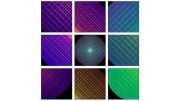

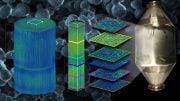
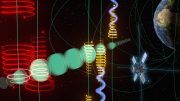

Be the first to comment on "“Dirty” Surprise: Webb Space Telescope Locates Dust Reservoirs in Two Supernovae"